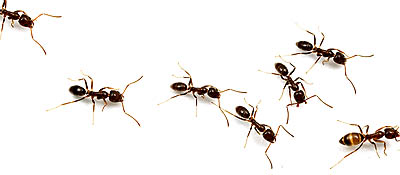
My earlier list of the most-studied ant species contained a few omissions. Here is a more inclusive list:
Ant species sorted by number of BIOSIS-listed publications, 1984-2008
| The Top 10 Species | Publications |
| Solenopsis invicta | 984 |
| Linepithema humile | 343 |
| Lasius niger | 250 |
| Formica rufa | 167 |
| Atta sexdens | 163 |
| Formica polyctena | 160 |
| Solenopsis geminata | 151 |
| Myrmica rubra | 142 |
| Monomorium pharaonis | 121 |
| Atta cephalotes | 112 |
| The Rest | Publications |
| Oecophylla smaragdina | 111 |
| Solenopsis richteri | 110 |
| Pheidole megacephala | 104 |
| Tetramorium "caespitum" | 93 |
| Formica fusca | 92 |
| Myrmica ruginodis | 88 |
| Pogonomyrmex barbatus | 87 |
| Lasius flavus | 87 |
| Wasmannia auropunctata | 79 |
| Atta laevigata | 79 |
| Pogonomyrmex rugosus | 79 |
| Leptothorax acervorum | 75 |
| Myrmica scabrinodis | 70 |
| Formica lugubris | 69 |
| Acromyrmex octospinosus | 67 |
| Formica cunicularia | 65 |
| Messor barbarus | 62 |
| Myrmica sabuleti | 62 |
| Anoplolepis gracilipes | 60 |
| Formica sanguinea | 60 |
| Formica exsecta | 60 |
| Formica pratensis | 60 |
| Atta colombica | 60 |
| Paraponera clavata | 58 |
| Eciton burchellii | 54 |
| Tapinoma melanocephalum | 54 |
| Lasius fuliginosus | 54 |
| Formica truncorum | 48 |
| Polyergus rufescens | 48 |
| Ectatomma tuberculatum | 48 |
| Myrmecia pilosula | 47 |
| Temnothorax albipennis | 45 |
| Paratrechina longicornis | 44 |
| Formica rufibarbis | 43 |
| Ectatomma ruidum | 43 |
| Cataglyphis bicolor | 42 |
| Cataglyphis cursor | 41 |
| Camponotus floridanus | 41 |
| Camponotus rufipes | 40 |
I did not comprehensively list every species below 40 publications, but I did tally a few out of curiosity:
| Camponotus rufipes | 40 |
| Iridomyrmex purpureus | 39 |
| Camponotus pennsylvanicus | 39 |
| Camponotus herculeanus | 39 |
| Tapinoma sessile | 38 |
| Formica cinerea | 38 |
| Lasius alienus | 35 |
| Formica japonica | 34 |
| Oecophylla longinoda | 34 |
| Myrmica lobicornis | 32 |
| Harpagoxenus sublaevis | 32 |
| Plagiolepis pygmaea | 31 |
| Technomyrmex "albipes" | 31 |
| Pachycondyla villosa | 29 |
| Tapinoma nigerrimum | 28 |
| Pogonomyrmex badius | 28 |
| Tetramorium bicarinatum | 28 |
| Pogonomyrmex californicus | 27 |
| Temnothorax curvispinosus | 26 |
| Polyergus breviceps | 25 |
| Formica subsericea | 24 |
| Lasius neoniger | 22 |
| Aphaenogaster cockerelli | 20 |
| Harpegnathous saltator | 18 |
| Ponera coarctata | 14 |
| Lasius japonicus | 14 |
The updated list retains the same defining characteristics as the earlier one: the most studied species tend to be either trampy or European. Data and methods are here.
More like this
Jesus Velazquez Mendizabal, 43, suffered fatal traumatic injuries on Friday, November 28, while working for Formica Construction in Travis, NY located on Staten Island.
Here's an old shot from the files:
 Formica accreta, Northern California
